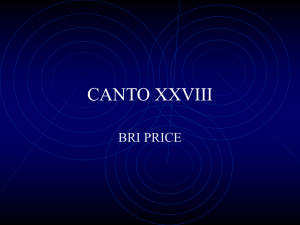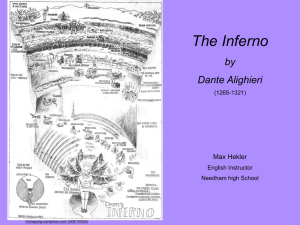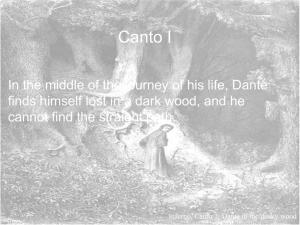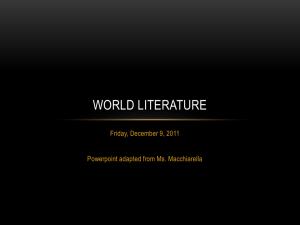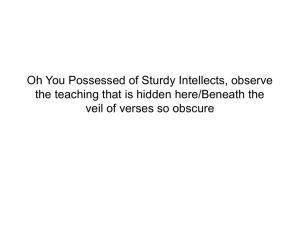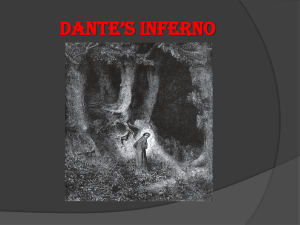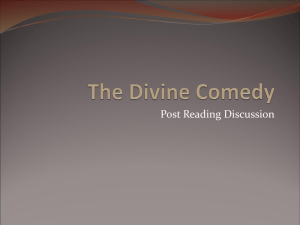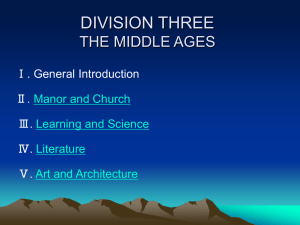The Divine Comedy
advertisement
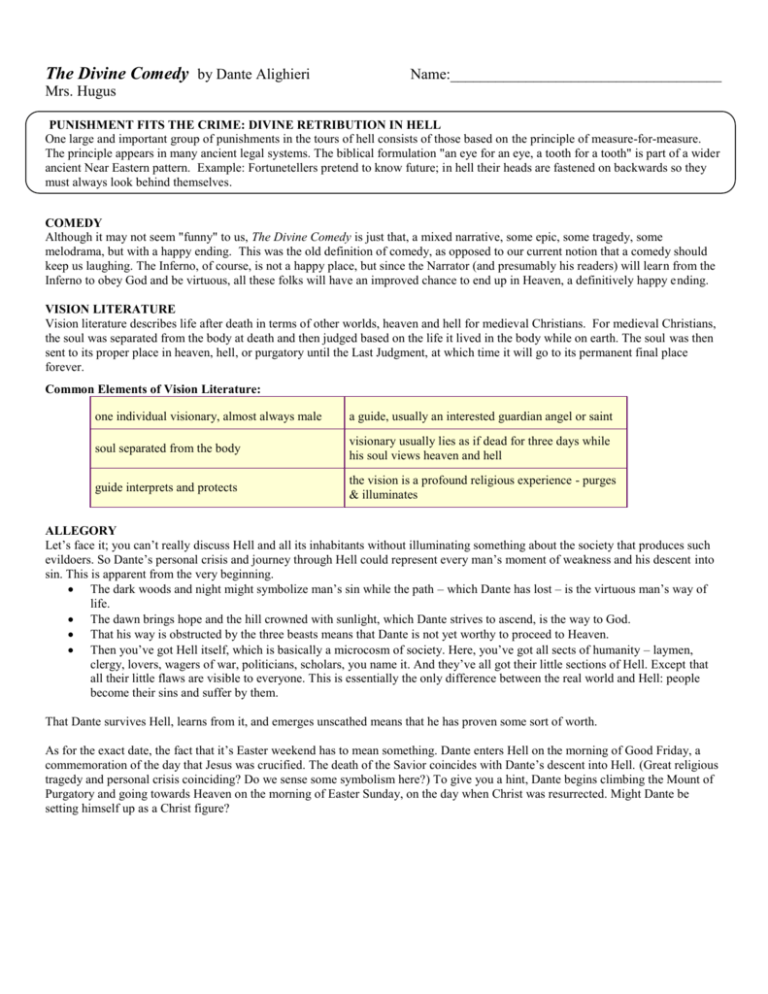
The Divine Comedy by Dante Alighieri Name:____________________________________ Mrs. Hugus PUNISHMENT FITS THE CRIME: DIVINE RETRIBUTION IN HELL One large and important group of punishments in the tours of hell consists of those based on the principle of measure-for-measure. The principle appears in many ancient legal systems. The biblical formulation "an eye for an eye, a tooth for a tooth" is part of a wider ancient Near Eastern pattern. Example: Fortunetellers pretend to know future; in hell their heads are fastened on backwards so they must always look behind themselves. COMEDY Although it may not seem "funny" to us, The Divine Comedy is just that, a mixed narrative, some epic, some tragedy, some melodrama, but with a happy ending. This was the old definition of comedy, as opposed to our current notion that a comedy should keep us laughing. The Inferno, of course, is not a happy place, but since the Narrator (and presumably his readers) will learn from the Inferno to obey God and be virtuous, all these folks will have an improved chance to end up in Heaven, a definitively happy ending. VISION LITERATURE Vision literature describes life after death in terms of other worlds, heaven and hell for medieval Christians. For medieval Christians, the soul was separated from the body at death and then judged based on the life it lived in the body while on earth. The soul was then sent to its proper place in heaven, hell, or purgatory until the Last Judgment, at which time it will go to its permanent final place forever. Common Elements of Vision Literature: one individual visionary, almost always male a guide, usually an interested guardian angel or saint soul separated from the body visionary usually lies as if dead for three days while his soul views heaven and hell guide interprets and protects the vision is a profound religious experience - purges & illuminates ALLEGORY Let’s face it; you can’t really discuss Hell and all its inhabitants without illuminating something about the society that produces such evildoers. So Dante’s personal crisis and journey through Hell could represent every man’s moment of weakness and his descent into sin. This is apparent from the very beginning. The dark woods and night might symbolize man’s sin while the path – which Dante has lost – is the virtuous man’s way of life. The dawn brings hope and the hill crowned with sunlight, which Dante strives to ascend, is the way to God. That his way is obstructed by the three beasts means that Dante is not yet worthy to proceed to Heaven. Then you’ve got Hell itself, which is basically a microcosm of society. Here, you’ve got all sects of humanity – laymen, clergy, lovers, wagers of war, politicians, scholars, you name it. And they’ve all got their little sections of Hell. Except that all their little flaws are visible to everyone. This is essentially the only difference between the real world and Hell: people become their sins and suffer by them. That Dante survives Hell, learns from it, and emerges unscathed means that he has proven some sort of worth. As for the exact date, the fact that it’s Easter weekend has to mean something. Dante enters Hell on the morning of Good Friday, a commemoration of the day that Jesus was crucified. The death of the Savior coincides with Dante’s descent into Hell. (Great religious tragedy and personal crisis coinciding? Do we sense some symbolism here?) To give you a hint, Dante begins climbing the Mount of Purgatory and going towards Heaven on the morning of Easter Sunday, on the day when Christ was resurrected. Might Dante be setting himself up as a Christ figure? Author Information and Background 1. With whom was Dante infatuated and what happened between them? 2. Although Dante was a poet and associated with literary people, in what else was he involved? 3. Why did Dante leave Florence and never return? 4. What is his greatest accomplishment? 5. The Divine Comedy takes the reader through three places. What are they? 6. Who does Dante encounter during his journey? 7. What are four uses of the number three? 8. Who is Virgil? 9. Who or what does “Dante” represent in the story? 10. What is a symbol? Canto One 11. Create a character profile for Dante. Describe as much as you can infer about this person. Analyze this quote in your profile: “When I first wandered there from the True Way?” 12. What time of year is it and where does Dante find himself? 13. Dante attempts to climb the little hill, but he is met with obstacles. What are they and, allegorically, what does all of this represent? 14. Who is Virgil? What is his role in this story? 15. What, according to the introduction, are the three places represented by the eternal place, the burning mountain, and the blessed choir? 16. Why do you think Dante accepts Virgil’s invitation to travel with him to the “sad halls of Hell?” Canto 3 17. Can you make any connections to a visit to the underworld from stories you have read in the past? 18. Interpret the message written on the gate of Hell. Who created this message? What is Dante’s reaction and is it appropriate? 19. Which souls can be found in the Vestibule to Hell? What is a vestibule and why is the punishment of the souls found there appropriate (use the words “symbolic retribution” in your answer)? 20. The banner that the Uncommitted chase is a symbol. What is a symbol and what does this banner symbolize? 21. What does Charon tell Dante is the reason he cannot cross into Hell? Group Reflection: Dante believed that faith was the most important value in life. Next to faith, however, he saw reason as the highest human value. How do you define faith and reason? Which is more valued in today’s world? Which do you think should be more highly valued? Canto 5 22. Who is Minos and what role does he play in the Inferno? Describe his actions and determine their meaning. 23. Which sinners are described in Canto 5? How are these souls being punished and how does this punishment fit their crime? 24. List six figures from history that are included in this ring of Hell. 25. What did Paolo and Francesca do to deserve their punishment? What convenient details about their story does Francesca leave out when speaking to Dante, thus pushing the blame from herself to love? Canto 33 26. Why do you feel Dante uses ice and not fire for the lowest circles of Hell? 27. Who do Virgil and Dante encounter at the beginning of the ninth circle of Hell? What is one doing to the other? 28. What sins did these men commit in real life? How does their punishment fit their crimes? 29. Describe and interpret Ugolino’s dream. What does it all mean? 30. How did Ugolino and his children die? What does Ugolino mean by “hunger proved more powerful than grief”? 31. What was Friar Albergio’s crime? How is it that he is in Hell when he is still “alive?” Canto 34 32. Are there other souls in the last layer of Hell? Describe their positions in the ice. 33. Who is Lucifer and why is he being punished in Hell? What is his punishment? 34. Describe what Satan looks like. 35. Who are considered the worst three sinners? What are their crimes? What are their eternal punishments? 36. How did Dante and Virgil get out of Hell? Describe how they passed through the center of gravity. 37. Where must Dante travel now? Who will be his guide? Group Reflection: By his placement of different sinners in Hell, Dante ranks human sins from the least to the most serious. What sins do people today regard as the least serious? As the most serious? Why do you think so? GEOGRAPHY OF HELL: NINE CIRCLES OF INFERNO 1. Limbo 2. Lustful 3. Gluttonous 4. Avaricious & Prodigal 5. Wrathful & Sullen 6. Heretics CIRCLES 2 - 5: INCONTINENCE (SINS WITHOUT MALICE): 7. Violent (3 rings) CIRCLE 2 - LUSTFUL The second circle is the real beginning of hell. Here we see the principle of retribution: sinners tossed and whirled by winds as in life they were helpless in tempests of passion. Paolo and Francesca: they were murdered before they could repent carnal courtly love as sin. Dido, Cleopatra, Helen, Achilles, Tristan. 8. Fraudulent (10 rings) 9. Traitors (4 rings) VESTIBULE AND GATE – The entryway to Hell. People who are neither good, nor evil, but were only for themselves. Famous inscription: “Abandon all hope, ye who enter in.” CIRCLE 1-LIMBO—Dante finds himself across the great river Acheron and views the First Circle –Limbo. This circle is different from all the rest that he will visit. Here there is no punishment or torture. This place is inhabited by the "good pagans." These are the souls of those who died unbaptized; their only pain is that they will never see the face of God. Here Dante sees such great poets as Homer and Ovid. CIRCLE 3 – GLUTTONS This circle is guarded by Cerberus with three hungry heads that are appeased with clumps of mud; gluttons who feasted away their lives now lie like pigs in the muck, constantly besieged by hail and garbage. CIRCLE 4 – AVARICIOUS AND PRODIGAL Pluto, god of riches, guards the entrance to the fourth circle. Roll stones to crash against one another; opposites in life and in death; they abused material goods. CIRCLE 5 – WRATHFUL AND SULLEN Styx (river of hate) forms a marsh holding the openly wrathful who strike and bite one another; sullen lie under the surface of the marsh, just as their silent anger lay hidden during their lives. AN ANGEL COMES TO OPEN GATE TO DIS (SINS WITH MALICE) The abyss of the rest of hell is included within the walls of the city of Dis. CIRCLE 6 - HERETICS Heretics (somebody who holds or adheres to an opinion or belief that contradicts established religious teaching, especially one that is officially condemned by religious authorities) chose their own opinions instead of following the teachings of the Church. (Farinata, an epicurean (connoisseur) - epicureans believed there was no soul, that pleasure was the primary goal of life, and that everything dies with the body, so they get to spend eternity with their bodies in burning graves.) CIRCLE 7 - VIOLENCE (three rings) 7-1. Violent against Neighbors—First Ring: Violent against others; includes murderers and robbers. NOTE: Dante does not really distinguish between lives and property; submerged in Phlegethon - river of blood. Alexander the Great 7-2. Violent against Self –Second Ring: Violent against themselves - suicides (wasted their bodies) and squanderers (wasted their goods) NOTE: Dante does not differentiate much between the values of life and property. Suicides are trapped in wretched, uncomfortable trees and bushes; treated own body poorly, don’t get it anymore. 7-3. Violent against God—Third Ring: Violent against God - blasphemy and denial; the worst kind of violence in Dante's world-view. Suffering by running and huddling on burning hot sand. CIRCLE 8 FRAUD: MALEBOLGE OF FRAUD (ten rings within for the ten kinds of malicious fraud) Fraud starts at the base of an abyss, so Dante and Virgil must descend on the back of the Fraud Monster, Geryon, who has a pleasant face and a snake-like body, to symbolize the pleasant first appearance of fraud and its twisted snaky dealings. Bolge 1 Panderers and Seducers - whipped by devils Bolge 2 Flatterers- are sunk in excrement - Jason Bolge 3 Simonists-- trade the grace and favor of the church for money. Their punishment is a kind of reverse baptism; they are upside-down in fonts (holes) and baptized by fire, not water; several popes here; NOTE: Dante criticizes popes BECAUSE he is a devout Catholic. Bolge 4 Fortunetellers - they tried to foretell the future, so now their heads are on backwards. Tieresias Bolge 5 Grafters - Grafters or barrators trade the powers and favors of their political office for money, covered in hot pitch. Bolge 6 Hypocrites - they wear gorgeous cloaks lined with lead; pretty outside, awful inside; heavy cloaks force them to behave sedately, although seething within (inner anger); cloak true character in false appearance. Caiaphas Bolge 7 Thieves - turning into snakes and snakes turning into thieves - thieves steal other people's possessions; they cannot keep their own bodies. Bolge 8 Evil Counselors - Ulysses and Diomedes helped to destroy Troy with the Trojan horse scam. Ulysses cut loose from all human ties (home, family, etc.) to sail to the edge of the world. Deceit and pride, virtues in Homer's Odysseus, have become Ulysses' sins in the Christian middle ages. Bolge 9 Sowers of Discord - Mohammed, disemboweled. Dante thinks of Mohammed as a sinner whose religious beliefs led to discord and schism. Note the total intolerance for another religion; this is typical of the Christian middle ages and later, it led to many wars against those who believed differently (including different sects of Christians) and massacres of unbelievers as well as Christian heretics. Another sower of discord was Bertram de Born, a Provencal troubadour poet. He carries his head like a lantern because he used vicious scandals to separate Henry II of England from his eldest son. Therefore, his head is separated from his body. Bolge 10 Falsifiers - alchemists and counterfeiters. Sinon, the Greek in the Aeneid who let himself be captured by the Trojans and gave them a story about the Trojan Horse, which tricked them into bringing it into Troy. ANTAEUS hand-carries Virgil and Dante down to the last circle, circle 9. Antaeus was a giant from Greek myth who accosted passing strangers and wrestled them to death, because he was invulnerable while touching earth. Hercules killed him by holding him in the air to weaken him and then crushed him. CIRCLE 9 - TRAITORS IN COCYTUS--Cocytus is a frozen lake of ice; Satan is immobilized at the center. Cocytus includes four kinds of traitors. 9-1. Traitors to Kindred – Caina; named after Cain, the first murderer of a kinsman 9-2. Traitors to Country - Antenora; named after the Trojan Antenor who in the Middle Ages was believed to have betrayed Troy to the Greeks 9-3. Traitors to Guests - Ptolomea, named after Ptolomey, a captain of Jericho who invited guests to a banquet and then murdered them while they were his guests. 9-4. Traitors to Masters (or benefactors)- The Judecca is named for Judas Iscariot who betrayed Christ. Also includes Cassius and Brutus who betrayed Julius Caesar. This puts together the betrayal of masters of Church and State. The frozen center contains Satan total absence of goodness; absolute distance from God; Virgil and Dante climb down Satan's side to the center of the earth; turn around and start climbing up toward Purgatory, but that's another story.
